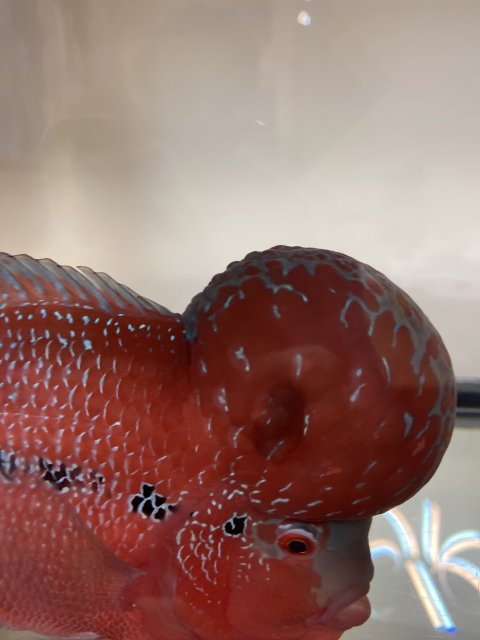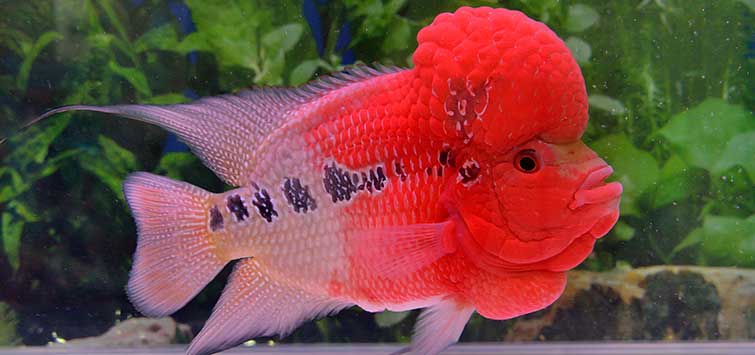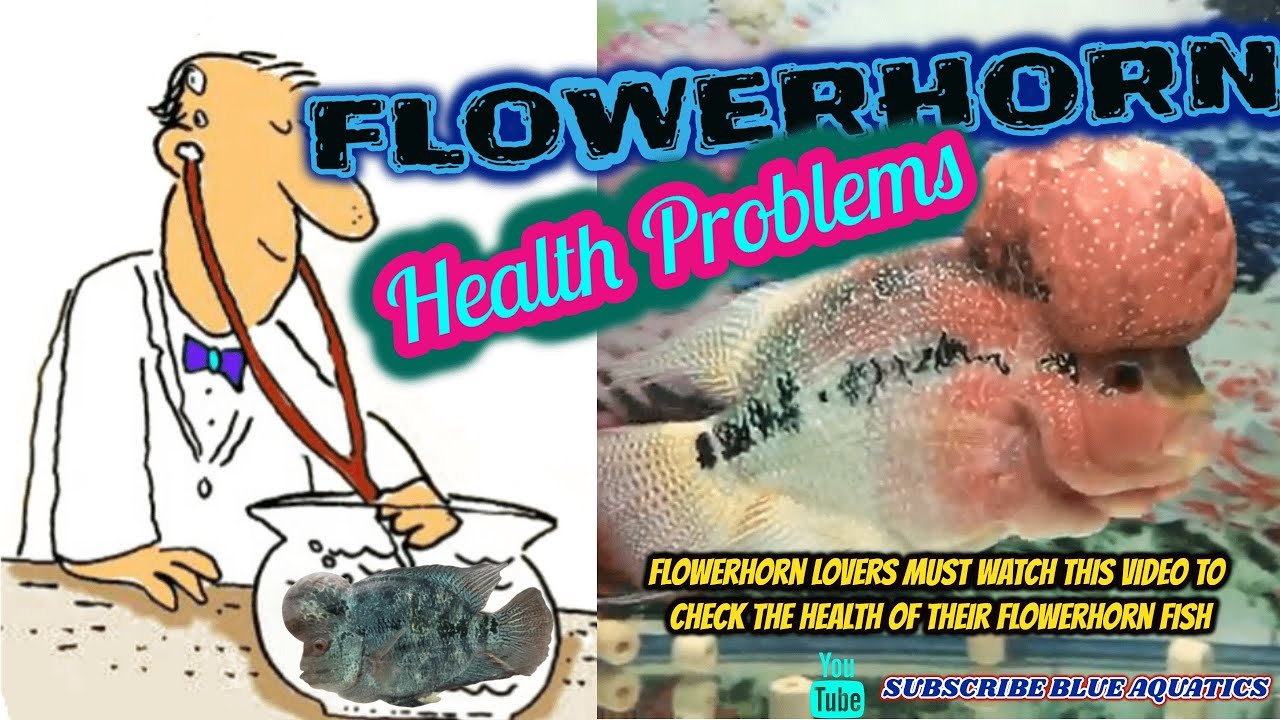Flowerhorn Cichlids often suffer from health problems like hole-in-the-head disease and swim bladder disorder. Poor water quality and improper diet are primary causes.
Flowerhorn Cichlids are popular for their vibrant colors and unique appearance. These fish require special care to maintain their health and well-being. Common health issues include hole-in-the-head disease, which results from poor water conditions and lack of essential nutrients. Swim bladder disorder often affects their buoyancy, making it difficult for them to swim properly.
Regular water changes, a balanced diet, and proper tank maintenance are crucial. Monitoring their health and promptly addressing any signs of illness can prevent severe complications. Ensuring optimal living conditions helps Flowerhorn Cichlids thrive and display their stunning beauty.

Credit: www.monsterfishkeepers.com
Common Health Issues
Flowerhorn cichlids are popular aquarium fish known for their bright colors and unique head shapes. Despite their beauty, they are prone to several health issues. Being aware of these problems helps in providing better care and ensuring a healthy, thriving fish.
White Spot Disease
White Spot Disease, also known as Ich, is common in Flowerhorn cichlids. It appears as small white dots on the fish’s body and fins. These spots are parasites that irritate the fish’s skin.
Symptoms:
- White spots on the body and fins
- Scratching against objects
- Loss of appetite
- Gasping for air at the surface
Treatment:
- Increase water temperature to 86°F (30°C)
- Add aquarium salt
- Use Ich medications as directed
- Maintain clean water conditions
Hole In The Head
Hole in the Head Disease is another issue affecting Flowerhorn cichlids. It is characterized by small pits or holes in the head and lateral line.
Symptoms:
- Small, pitted holes on the head
- Loss of color
- Reduced appetite
- Lethargy
Treatment:
- Improve water quality
- Provide a balanced diet
- Use medications specifically for Hole in the Head
- Ensure proper filtration
Flowerhorn cichlids require special care to prevent these health issues. Regular monitoring and prompt treatment ensure your fish stays healthy and vibrant.
Symptoms To Watch For
Flowerhorn cichlids are vibrant and captivating fish. Their health problems can be concerning. Being aware of symptoms can help you act quickly. Here are key symptoms to watch for in Flowerhorn cichlids.
Behavioral Changes
Behavioral changes can signal health issues. Watch for these behaviors:
- Lethargy: Fish stays at the bottom and moves less.
- Loss of Appetite: Fish refuses to eat or eats less.
- Erratic Swimming: Fish swims in circles or struggles to swim.
- Hiding: Fish hides more than usual, avoiding interaction.
- Aggression: Increased aggression towards other fish or its reflection.
Physical Signs
Physical signs are often easier to spot. Check your Flowerhorn cichlid for these signs:
| Sign | Description |
|---|---|
| White Spots | Indicates ich, a common parasitic infection. |
| Cloudy Eyes | May be a sign of bacterial infection. |
| Red Streaks | Could indicate a bacterial or fungal infection. |
| Bloated Body | Often a sign of dropsy or internal parasites. |
| Frayed Fins | May indicate fin rot or aggressive tank mates. |
Regularly inspect your Flowerhorn cichlid for these symptoms. Early detection is key to effective treatment.
Preventive Measures
Taking preventive measures is crucial to ensure the health of your Flowerhorn Cichlid. Simple steps can help avoid common health problems. Below, you will find essential guidelines to maintain your fish’s well-being.
Water Quality
Maintaining excellent water quality is vital for your Flowerhorn Cichlid’s health. Poor water conditions can lead to stress and disease. Here are some key points to ensure optimal water quality:
- Regular Water Changes: Change 20-30% of the tank water weekly.
- Proper Filtration: Use a high-quality filter suitable for the tank size.
- Monitor Parameters: Keep pH levels between 7.4 and 8.0. Maintain water temperature between 78-84°F.
- Avoid Overcrowding: Provide ample space for each fish to reduce stress.
Proper Diet
A balanced diet ensures that your Flowerhorn Cichlid receives all essential nutrients. Poor nutrition can lead to various health issues. Follow these guidelines for a proper diet:
- High-Quality Food: Use pellets specifically designed for cichlids.
- Variety in Diet: Include live, frozen, and freeze-dried foods. Options are brine shrimp, bloodworms, and krill.
- Avoid Overfeeding: Feed small portions twice a day. Remove uneaten food after 5 minutes.
| Diet Component | Frequency |
|---|---|
| Pellets | Daily |
| Live Food | 2-3 times a week |
| Vegetables | Once a week |
Ensure your Flowerhorn Cichlid has a varied and balanced diet. This helps in preventing malnutrition and enhances their vibrant colors.

Credit: www.youtube.com
Quarantine Procedures
Flowerhorn Cichlids are vibrant and hardy fish. But they are not immune to health problems. Quarantine procedures are essential to keep them healthy. These procedures prevent the spread of diseases in your tank. Let’s explore the steps involved in quarantine procedures.
New Fish Introduction
When you bring a new fish home, quarantine is crucial. It helps ensure the new fish is healthy before joining others. Keep the new fish in a separate tank for at least two weeks. This period allows you to monitor for any signs of illness.
During quarantine, observe the new fish closely. Look for symptoms like white spots, fin rot, or unusual behavior. If any of these signs appear, treat the fish immediately.
Infection Control
Infection control is vital during the quarantine period. Use separate equipment for the quarantine tank. This includes nets, feeding tools, and cleaning supplies. Avoid cross-contamination between tanks.
Maintain excellent water quality in the quarantine tank. Regularly check the water parameters like pH, ammonia, and nitrite levels. Clean water reduces stress and helps the fish recover quickly.
| Parameter | Optimal Range |
|---|---|
| pH | 6.5 – 7.5 |
| Ammonia | 0 ppm |
| Nitrite | 0 ppm |
Monitor the fish daily for any changes in health. If you notice any signs of disease, take action immediately. Early detection and treatment are key to preventing the spread of infections.
- Use separate equipment for quarantine tank.
- Maintain excellent water quality.
- Monitor the fish daily.
Stress Reduction
Maintaining a stress-free environment is essential for Flowerhorn Cichlid health. Stress can lead to serious health problems and even shorten their lifespan. There are several key factors to consider for reducing stress in Flowerhorn Cichlids.
Tank Environment
Creating the right tank environment is crucial for Flowerhorn Cichlid well-being. Ensure the tank size is adequate; at least 55 gallons is recommended. Maintain water parameters within optimal ranges:
| Parameter | Optimal Range |
|---|---|
| Temperature | 80-86°F (27-30°C) |
| pH Level | 6.5-7.8 |
| Ammonia | 0 ppm |
| Nitrite | 0 ppm |
| Nitrate | <20 ppm |
Use a high-quality filter to keep the water clean. Add hiding spots and decorations to mimic their natural habitat. Ensure proper lighting, but avoid excessive brightness.
Compatible Tank Mates
Choosing compatible tank mates is essential for reducing Flowerhorn Cichlid stress. Avoid keeping Flowerhorns with overly aggressive species. Ideal tank mates include:
- Blood Parrot Cichlids
- Oscars
- Green Terrors
- Severums
Avoid small fish as Flowerhorns may see them as prey. Monitor interactions and separate fish if aggression occurs. This ensures a peaceful tank environment, reducing stress for all inhabitants.
Nutritional Needs
The Flowerhorn Cichlid is a popular aquarium fish known for its vibrant colors and unique appearance. To keep it healthy, its nutritional needs must be met. A balanced diet ensures the fish thrives and prevents health problems.
Balanced Diet
A balanced diet is crucial for Flowerhorn Cichlids. It should include a mix of proteins, vitamins, and minerals. High-quality pellets are a great staple food. Look for pellets that contain at least 40% protein.
Include fresh or frozen foods too. These can be brine shrimp, bloodworms, and krill. These foods provide essential nutrients and keep the fish active.
Feed your Flowerhorn two to three times a day. Ensure the food is consumed within two minutes to avoid overfeeding.
Supplemental Foods
Supplemental foods are important to enhance the diet. They provide extra nutrients and variety. Here are some good options:
- Vegetables: Peas, spinach, and zucchini are good choices. They help with digestion.
- Live Foods: Small fish and insects can be offered occasionally. They stimulate natural hunting instincts.
- Specialty Foods: Color-enhancing foods can improve the fish’s appearance.
Use a feeding schedule to ensure consistency. Avoid feeding the same food every day. Rotate between different food types for a balanced diet.
| Food Type | Frequency | Benefits |
|---|---|---|
| High-Quality Pellets | Daily | Provides essential nutrients |
| Fresh/Frozen Foods | 2-3 times a week | Variety and enrichment |
| Vegetables | Once a week | Aids digestion |
| Live Foods | Occasionally | Stimulates hunting instincts |
| Specialty Foods | Occasionally | Enhances color |
Regular Health Checks
Regular health checks are crucial for your Flowerhorn Cichlid. These checks help spot early signs of illness. Early detection leads to better treatment outcomes. Healthy fish are happier and more vibrant. Below are key elements of a good health check routine.
Routine Inspections
Inspect your Flowerhorn Cichlid daily. Check for changes in behavior or appearance. Look for abnormal swimming patterns. Examine the fish for any discoloration or spots. Observe the eyes for cloudiness or swelling.
Use a flashlight to inspect the gills. Healthy gills are bright red. Pale or discolored gills may indicate health issues. Check the fins for tears or fraying. Healthy fins are smooth and intact.
Monitor the fish’s appetite. A sudden change in eating habits can signal problems. Keep an eye on the tank’s water quality. Poor water conditions can affect your fish’s health.
Professional Consultations
Schedule regular visits to a fish vet. A professional can conduct a thorough health check. They can identify issues you might miss. Regular vet visits ensure your fish stays healthy.
Discuss any concerns with the vet. Share observations from your routine inspections. The vet can provide advice on treatment and care. They can also recommend the best diet for your Flowerhorn Cichlid.
Keep a record of vet visits and treatments. This helps track your fish’s health history. It’s useful for future consultations.
| Health Check | Frequency |
|---|---|
| Daily Inspection | Every day |
| Water Quality Check | Every week |
| Vet Visit | Every 6 months |
Implement these health checks to keep your Flowerhorn Cichlid healthy. Regular checks are key to a vibrant and lively fish.
Emergency Care
Flowerhorn Cichlids are vibrant and hardy fish, but emergencies can happen. Quick action can save your fish’s life. Below, you’ll find essential steps for dealing with emergencies.
First Aid Steps
Immediate care is crucial during emergencies. Follow these first aid steps to stabilize your Flowerhorn Cichlid:
- Isolate the Fish: Place the fish in a quarantine tank.
- Check Water Parameters: Ensure optimal water conditions.
- Temperature: Maintain a stable temperature of 78-80°F.
- Oxygenate the Water: Use an air pump or air stone.
- Observe Behavior: Look for signs like rapid breathing or erratic swimming.
- Administer Medications: Use appropriate treatments for visible symptoms.
When To Seek Help
Sometimes, home remedies aren’t enough. Recognize when to seek professional help:
- Persistent Symptoms: If symptoms persist for more than 48 hours.
- Severe Injury: If the fish has deep wounds or severe fin damage.
- Rapid Decline: If the fish’s condition worsens quickly.
- Unresponsive to Treatment: If there’s no improvement with first aid.
- Expert Advice: Consult a vet specializing in aquatic animals.
Timely intervention can make a big difference. Be prepared and act swiftly during emergencies.

Credit: www.tfhmagazine.com
Frequently Asked Questions
How To Treat Sick Flowerhorns?
Treat sick flowerhorns by isolating them in a quarantine tank. Use appropriate medications for specific diseases. Maintain optimal water conditions and diet. Consult a vet for severe cases.
How Do I Know If My Flowerhorn Is Healthy?
Check vibrant colors, clear eyes, and active swimming. Ensure a hearty appetite and regular bowel movements. Observe for no visible injuries or unusual spots.
Are Flowerhorns Difficult To Care For?
Flowerhorns require moderate care. Maintain clean water, proper diet, and stable water parameters. They’re hardy but need attention.
How Long Do Flowerhorn Cichlids Live?
Flowerhorn cichlids typically live for 10-12 years. With proper care, they can sometimes reach up to 15 years.
Conclusion
Caring for a Flowerhorn Cichlid requires attention to their unique health needs. Regular check-ups and proper diet can prevent many issues. Keep the tank clean and monitor water quality. Always consult a vet if you notice any unusual symptoms. A healthy Flowerhorn Cichlid brings joy and beauty to your aquarium.
